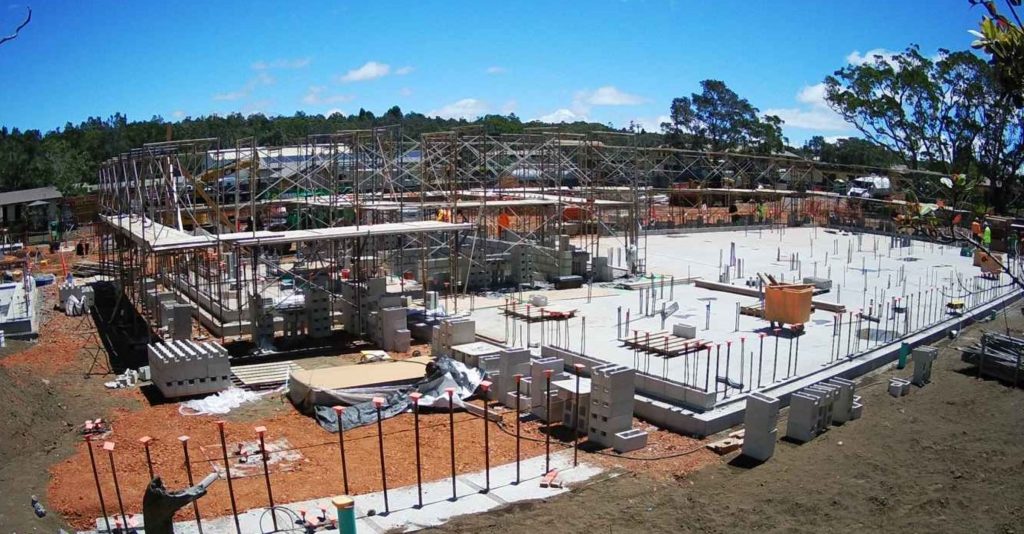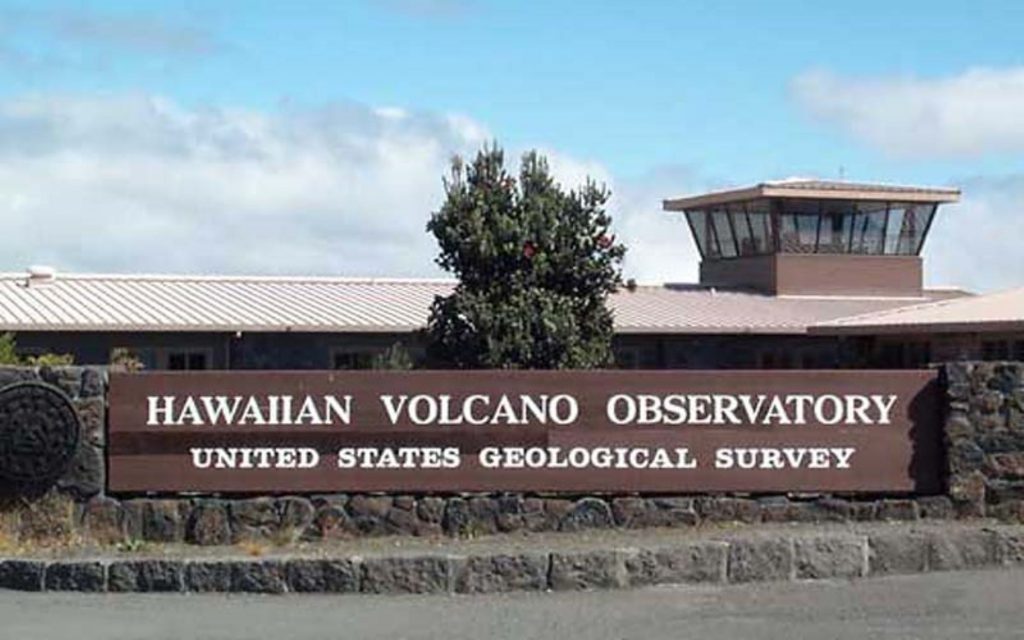Staff, community remember former Hawaiian Volcano Observatory, Jaggar Museum as demo nears completion
This story was updated at 1:04 p.m. July 26.
Its watch has ended.
This morning was the last time the sun will ever rise over the former Hawaiian Volcano Observatory Tower as it looked out on the hardened lava field inside Kaluapele, the caldera of Kīlauea, from the edge of the crater.

Crews began demolishing the structure at 9 a.m. today, bringing an end to an era on Uēkahuna Bluff at the Big Island volcano’s summit inside Hawai‘i Volcanoes National Park.
“Workers took less than an hour Friday morning to drop and dismantle the … Hawaiian Volcano Observatory … Observation Tower,” wrote Jessica Ferracane, the national park’s spokeswoman, in a Facebook post for the park Friday with photos of the tower being dismantled.
The tower was the last remnant of the observatory’s former facilities, which — along with the adjacent former Jaggar Museum — were severely damaged beyond repair by thousands of earthquakes that accompanied the 2018 Kīlauea eruption, lava flow and summit collapse.
The lower East Rift Zone eruption and summit collapse were the most destructive eruptive events in past 200 years Hawaiʻi. Hundreds of homes and buildings in lower Puna were destroyed, and the national park closed for 134 days.
Demolition of the tower was supposed to happen Thursday but was postponed to today.
It’s part of the first phase of the park’s disaster recovery project, which includes:
- Removal of the former museum, the park’s first museum that was called “Uwekahuna Museum” when its original buildings were completed in 1927.
- Demolition of the former Hawaiian Volcano Observatory’s Okamura Building built in 1986, where the tower was located.
- Dismantling of a former geochemistry annex.
The museum and observatory buildings now no longer stand, and demolition at the science and museum campus is nearing completion. Work began in early April.
The observatory was located on the edge of the caldera for 76 years. It was first housed in the building that later became the improved Jaggar Museum before moving to the larger Okamura Building after its completion.
The largest addition to the campus was named after longtime Hawaiian Volcano Observatory Chief of Operations Reginald T. Okamura, whose career at the observatory spanned 34 years from 1958 to 1992.
Born in Kaʻū, the Hilo man known as the “voice of the volcano” died in January 1999 after falling into a coma following a heart attack several days earlier. He was 62 years old.
The removal of the buildings on the Uēkahuna Bluff also closes out the 96-year history of the Jaggar Museum.
The museum’s namesake geologist and renowned volcanologist Thomas A. Jaggar introduced the notion of having a permanent geologic observatory and laboratory on the the Big Island. He began his efforts in 1909 and the observatory was founded in 1912.
Jaggar also managed the research program in the national park for decades.
“For many of us, [the Hawaiian Volcano Observatory] was like a second home, and you can imagine how difficult it would be to see it being slowly dismantled and now nearly gone,” said geologist Matt Patrick, who started working with the observatory in 2007.
Ferracane in the park’s post Friday said the tower provided scientists with a 360-degree vantage point for studying Kīlauea and Mauna Loa volcanoes.
“It was an ideal location for monitoring the summit activity, and every day felt like a privilege to be able to work so closely to the activity,” said Patrick.
He added the lave lake inside Kīlauea’s Halema‘uma‘u Crater — which was dramatically reshaped by the summit collapse and subsequent eruptions in 2018 — and summit caldera from 2008 to 2018 reinforced the value of having observatory research and observation facilities on the rim of Kaluapele.
“It’s important to realize that much of [the Hawaiian Volcano Observatory’s] original mission and Jaggar’s vision was based on its proximity to the activity, to closely observe and measure and test new methods for volcano monitoring,” said Patrick.

The 5 summit eruptions since 2020 also illustrate that the summit remains a focus of activity at Kīlauea, so having a facility close enough for eruption response is crucial.
As one era ends, a new one begins.
The park’s recovery project includes the construction of a new Hawaiian Volcano Observatory field station adjacent to the historic ball field adjacent to Kīlauea Military Camp, which is already underway.
That’s a little more than a mile from the former site, “and waaaay back from the crater’s edge,” Ferracane wrote in the park’s Friday post, but still close to the caldera and inside the park.
“[The Hawaiian Volcano Observatory] has been near the rim of the caldera, in various spots, since it started in 1912, so the new field station will continue that tradition,” Patrick said. “As the old building is taken down, the new one is being built. So it’s an interesting time for [the Hawaiian Volcano Observatory].”
Kīlauea Visitor Center will also be renovated and expanded in the second phase of the recovery project, which should begin sometime this fall, to take over where the former Jaggar Museum left off.
Ferracane wrote in a July 22 post on Facebook that the revered area where the observatory and museum once stood will eventually reopen to Hawaiian cultural practitioners and visitors, only without buildings.
Only the historic low rock walls and viewing platform will remain, leaving awe-inspiring Kaluapele alone to again dominate the viewscape.
“The wahi pana [storied place] of Uēkahuna will continue to evolve, just like Kīlauea,” Ferracane said in the park’s Friday post.
Hawaiian Volcano Observatory Scientist-in-Charge Ken Hon said construction of the new field station is estimated to be completed by late 2025, so it won’t be too long before the next wave of volcanic research will build within its walls.
“[Hawaiian Volcano Observatory] staff are looking forward to using the field station as a starting point for field work and observations near Kīlauea summit,” said Hon.
While the future is secured for observatory scientists to still be near the caldera to study, monitor and measure activity at the volcano, the demolition is still a solemn moment for the scientists who fulfilled important work in the former facilities as well as community members.
Janice Norman of Volcano is a University of Hawai‘i at Hilo graduate who majored in geology with a specialty in volcanology. She now co-owns Leaky Mountain Tours in Hilo, offering educational tours to Kīlauea and other locations of interest around the Big Island.
Norman said seeing the demolition of the tower and other buildings on the former research and museum campus is bittersweet.
“Many of us have spent a significant amount of time in the [Hawaiian Volcano Observatory] building and Jaggar Museum,” wrote Norman in a July 22 post in the We Love Kīlauea and Mauna Loa Volcanoes group on Facebook, for which she is an administrator. “In 2008, when the eruption started in Halemaʻumaʻu Crater, this vantage point was unmatched.”
Alas, the damage done in 2018 was sadly too much to handle for the buildings: “In consequence, we bid adieu. A new viewing area will be in its place that keeps in accord with Hawaiian traditions.”
Audra Gray replied to the national park’s Facebook post, saying the dismantling of the buildings is a solemn occasion indeed, but she is excited about what the future holds.
“A lot of science [was] accomplished there,” wrote Gray. “Thanks to those who served there and contributed to our knowledge of volcanoes and Hawai‘i. Looking forward to learning more from data collected at the new location.”
The park at the end of its post, which had 88 comments, more than 1,100 reactions and had been shared 117 times by early Thursday evening, asked people if they could talk to the former Jaggar Museum and observatory facilities, what would they say?
“I would say, ‘Mahalo for the years of Girl Scout and school field trips, your interactive computer machines (IDK what to call those things!) were so fun and advanced! And the burned suit is burned in my memory,” replied Kahualani Aitken. “Thank you, thank you, thank you. Looking future forward. Mahalo for the memories.”
Connie Bigelow also thanked the Hawaiian Volcano Observatory and museum for sharing their research and knowledge: “You had the best view of Pele’s workshop,” she said, referring to the Hawaiian volcano goddess.
Observatory staff members have worked out of multiple temporary locations, including offices at the Hilo Ironworks Building, since 2018 after having to leave their longtime home.
A new headquarters, which will be shared with the Pacific Island Ecosystems Research Center, is being constructed on 6.8 acres of state-owned land off Nowelo Street in Hilo, near the intersection with Komohana Street and on the campus of the University of Hawai‘i at Hilo.
“This facility will house state-of-the-art laboratories and proximity to [UH-Hilo] will allow more opportunities for collaboration with faculty and students,” Hon said.
During a blessing ceremony last year for the new facility’s site, construction was estimated to be done in late 2025, but Hon said the completion date is now expected to be later.

The former Jaggar Museum and observatory site will be missed by Susan Wilmes.
“I’m sad when I see this,” said Wilmes in reply to the park’s Facebook post. “So many memories of special times around the crater’s edge, of ranger talks during the evening glow.”
Park officials replied, reassuring her that those ranger talks will happen there again, just without the buildings. She understood, but that only soothed her sadness so much.
“It was that magical patio on the side of the crater where I felt all the mana from Pele,” Wilmes wrote back before alluding to a recent spike in activity under Kīlauea’s upper East Rift Zone, which observatory scientists, just like they did right there looking out from the tower, continue to monitor closely. “She’ll be around, and maybe sooner than later, huh?”
Sponsored Content
Comments























